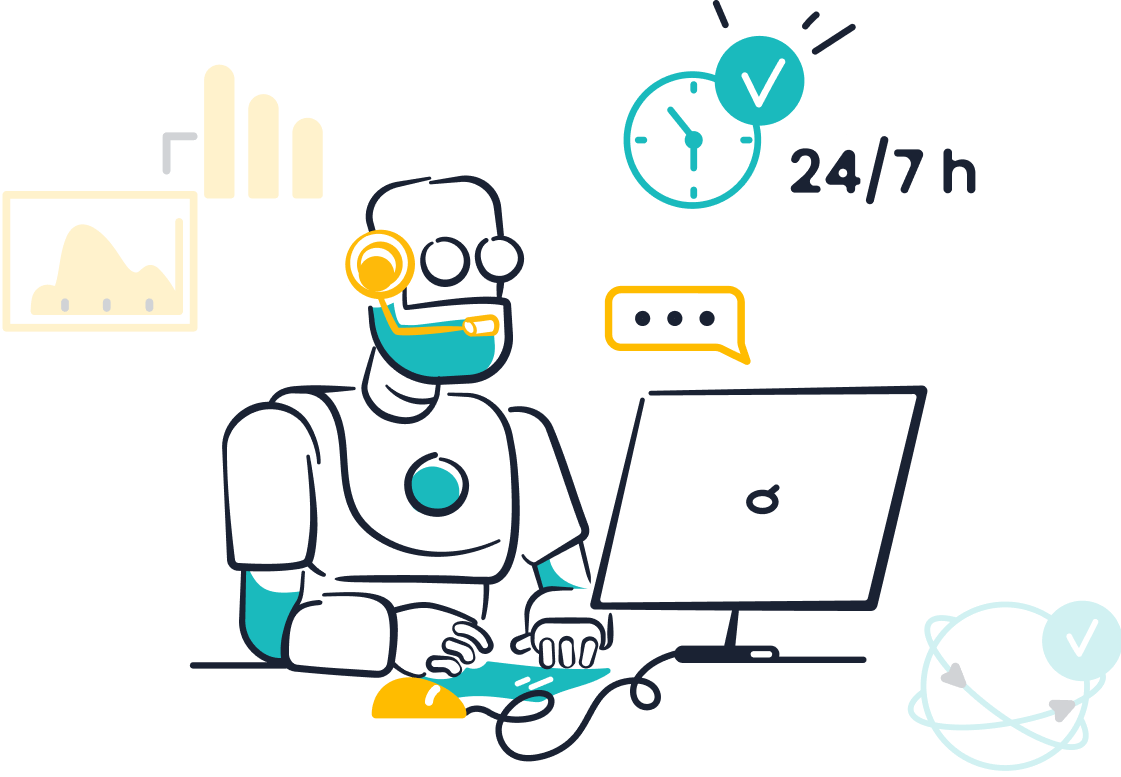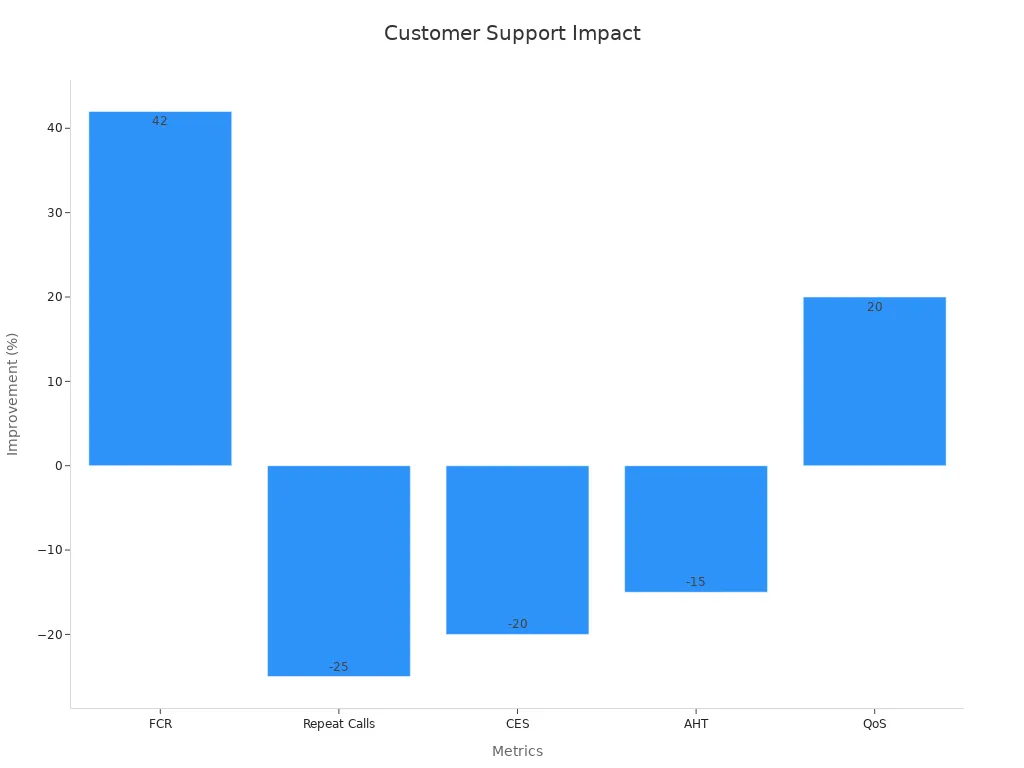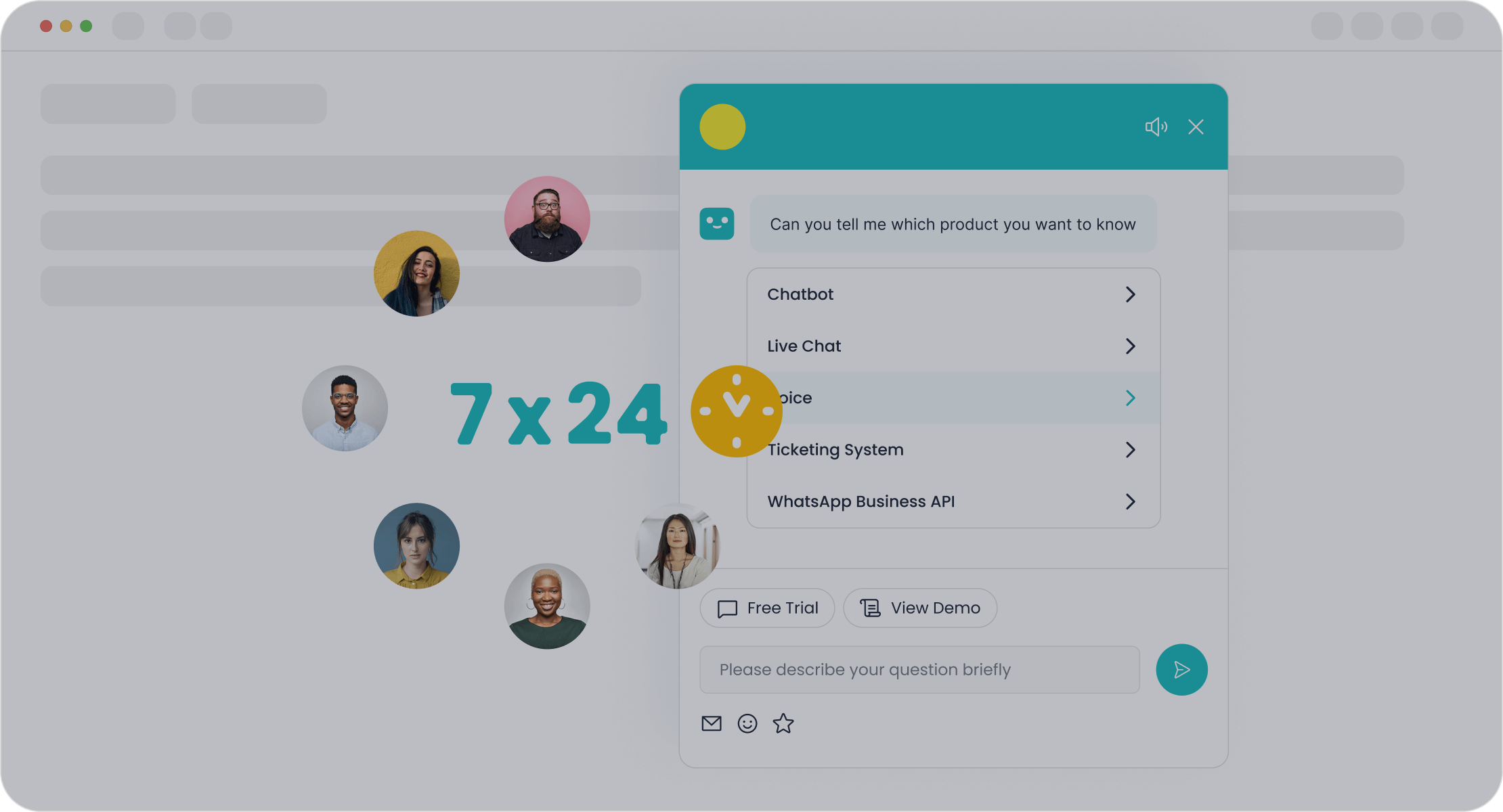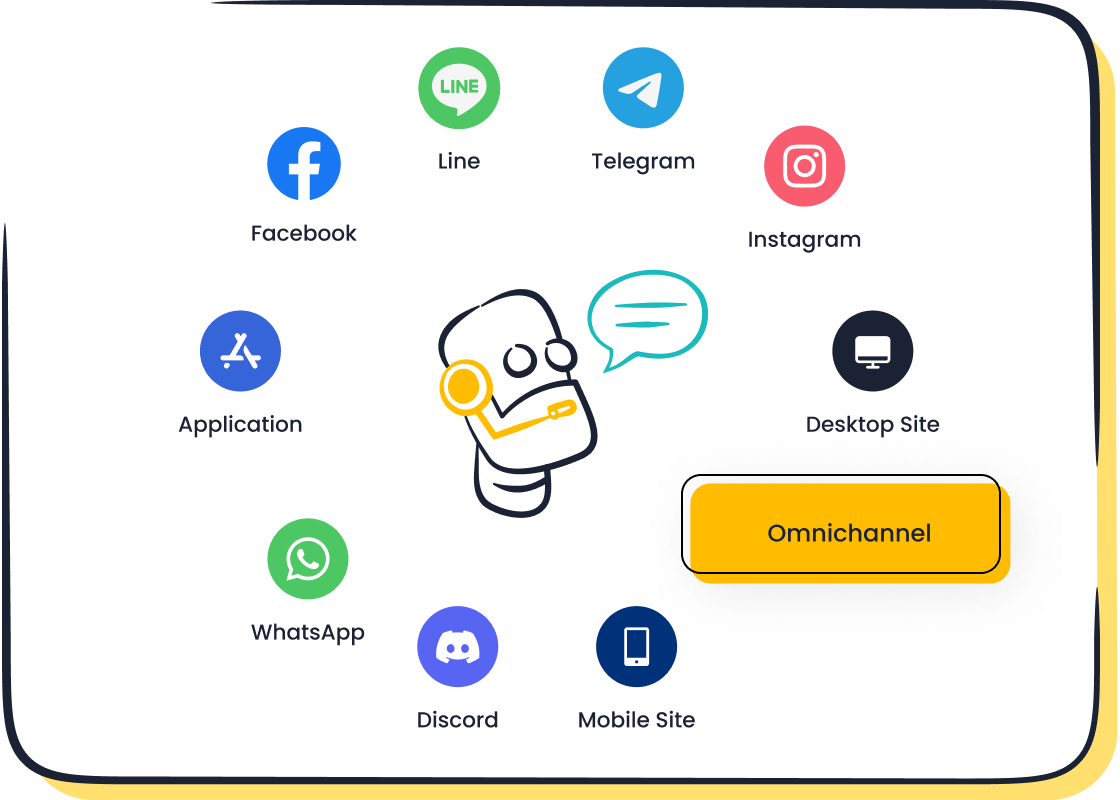Why Chatbot Analytics Dashboards Boost Team Efficiency

A chatbot analytics dashboard gives customer support teams the power to work smarter and faster. Real-time data and data-driven insights help teams spot trends, identify friction points, and optimize workflows. Companies using dashboards see major gains, such as:
- Deflection rate improvements, with chatbots handling up to 70% of inquiries and cutting support costs by 30%.
- Higher customer satisfaction scores, better retention, and increased conversion rates.
- Faster average handle times and more accurate responses.
Surveys show that real-time data boosts operational efficiency by up to 30% and reduces costs by 25%. The chart below highlights measurable improvements in service quality:

Sobot leads in delivering intelligent, all-in-one solutions. The Sobot AI chatbot and unified dashboard equip teams with actionable metrics, driving efficiency and better customer experiences.
Chatbot Analytics Dashboard Basics

What Is a Chatbot Analytics Dashboard
A chatbot analytics dashboard is a centralized platform that displays real-time data and performance metrics related to chatbot interactions. This dashboard provides teams with a clear view of how users engage with the chatbot, highlighting trends and areas for improvement. Industry reports identify several core functionalities that define a robust chatbot analytics dashboard:
- Number of interactions and total conversations
- Average chat duration and session length
- Engagement rate and retention rate
- Goal completion rate and resolution rate
- Customer satisfaction score (CSAT)
- Human handoff rate and error rate
- Topic frequency and user sentiment
- Abandonment rate and AI response feedback
These analytics tools can be built-in, third-party, or custom dashboards integrated with business intelligence platforms. The Sobot chatbot analytics dashboard, for example, offers built-in analytics and seamless integration with omnichannel solutions, making it easy for teams to monitor key metrics and optimize performance. By focusing on actionable data rather than vanity statistics, organizations can identify friction points and drive continuous improvement.
Role in Customer Support
A chatbot analytics dashboard plays a vital role in customer support by transforming raw data into data-driven insights. Teams use analytics to monitor chatbot performance, track user satisfaction, and pinpoint areas needing attention. For instance, a commercial bank reported a 2,350% increase in chatbot interactions and a jump in problem-solving rates from 77% to 92% after implementing analytics dashboards. The dashboard tracks metrics such as response time, resolution rate, and customer satisfaction, helping teams deliver faster and more accurate support.
| Metric | Description | Impact on Support |
|---|---|---|
| Number of Users | Tracks chatbot reach and engagement | Higher adoption |
| Response Time | Measures speed of chatbot replies | Faster support, higher CSAT |
| Completion Rate | Shows how often chatbots resolve user requests | More effective issue resolution |
Sobot’s chatbot analytics dashboard empowers organizations to streamline workflows, reduce agent workload, and improve customer experiences. By leveraging real-time data, teams can make informed decisions that boost operational efficiency and customer satisfaction.
Key Features for Customer Support
Real-Time Data
Real-time data stands at the core of effective chatbot analytics. Customer support teams need instant access to information about chatbot interactions, user engagement, and performance trends. Simulation data from Dimension Labs shows that integrating real-time data with AI-powered enrichment allows teams to upload and analyze information instantly. This approach replaces manual tagging and enables unlimited, goal-based segmentation. Sobot’s chatbot analytics dashboard delivers real-time data across all channels, helping teams detect trends, spot anomalies, and optimize support processes quickly. With predictive scoring and AI-driven insights, teams can prioritize actions that have the greatest financial impact. This level of analytics ensures that every customer interaction receives timely attention, which improves both user experience and operational efficiency.
User-Friendly Interface
A user-friendly interface makes chatbot analytics accessible to everyone on the team. Sobot’s unified workspace brings together chatbot data, analytics, and customer profiles in one easy-to-navigate dashboard. This design supports fast decision-making and reduces training time for new agents. The table below highlights how a user-friendly interface benefits customer support metrics:
| Metric | Description | User-Friendly Interface Benefit |
|---|---|---|
| Customer Satisfaction | Post-interaction ratings and feedback | Clear dashboards reveal satisfaction trends for quick action |
| Session Length | Duration of chatbot-user interaction | Simple UI keeps users engaged and improves user experience |
| Retention Rate | Repeat usage of the chatbot | Easy analytics help teams boost user engagement and loyalty |
| Response Time | Speed of chatbot replies | Real-time metrics enable faster optimization |
Customer feedback from organizations like Dropbox and Concentrix confirms that intuitive dashboards enhance user experience, improve self-service, and drive higher retention.
Integration and Customization
Integration and customization are essential for maximizing chatbot analytics. Sobot’s omnichannel solution connects chatbot data from voice, chat, email, and social media into a single dashboard. Teams can customize analytics views, set up goal-based segments, and tailor reports for different stakeholders. AI-embedded reporting provides accurate, real-time analytics and supports evolving customer questions. Customization helps teams adapt to changing needs, refine chatbot responses, and enhance user experience. Sobot’s flexible integration ensures that analytics align with business goals and support continuous improvement in user engagement and support quality.
Essential Chatbot Analytics Metrics
A chatbot analytics dashboard empowers support teams to track, measure, and improve performance using essential metrics. These analytics provide a clear view of chatbot effectiveness, helping teams identify trends and drive continuous improvement. Sobot’s analytics dashboard offers robust reporting and optimization features, making it easy to monitor key metrics and enhance customer satisfaction scores.
Response Time
Response time measures how quickly a chatbot replies to user messages. Fast response times increase user engagement and satisfaction. Sobot’s chatbot analytics dashboard displays real-time data on average response time, allowing teams to identify trends and optimize workflows. Studies show that faster response times lead to higher customer satisfaction scores and improved user engagement. For example, a lower average response time often results in more efficient support and happier customers.
| Metric | Definition | Impact |
|---|---|---|
| Average Response Time | Time taken for chatbot to reply to user queries | Faster replies boost satisfaction |
Sobot’s analytics help teams monitor response time, set benchmarks, and make data-driven decisions for continuous improvement.
Resolution Rate
Resolution rate tracks the percentage of user queries fully resolved by the chatbot without human intervention. High resolution rates indicate strong chatbot performance and efficient support. Sobot’s analytics dashboard provides detailed reports on resolution rate, helping teams identify trends and optimize chatbot responses. For instance, Healthspan’s chatbot achieved a 90% resolution rate, demonstrating the value of effective analytics.
Teams use Sobot’s analytics to pinpoint areas for improvement, refine chatbot scripts, and increase the number of issues resolved automatically. This leads to higher customer satisfaction and reduced agent workload.
Customer Satisfaction
Customer satisfaction measures how happy users feel after interacting with the chatbot. Analytics dashboards collect satisfaction data through post-interaction surveys and feedback forms. Sobot’s chatbot analytics dashboard tracks customer satisfaction scores, making it easy to identify trends and address issues quickly. High satisfaction scores reflect positive user experiences and effective chatbot support.
- Sobot’s analytics enable teams to monitor satisfaction, compare performance over time, and implement targeted improvements.
- AI-powered analytics can predict satisfaction based on chat language, helping teams act before issues escalate.
A recent mixed-methods study found a strong link between chatbot analytics metrics—especially those related to social support—and improved employee performance in customer support roles.
Fallback and Escalation
Fallback and escalation metrics show how often the chatbot cannot resolve an issue and must transfer the conversation to a human agent. These analytics help teams identify trends in chatbot limitations and improve training. Sobot’s analytics dashboard tracks escalation rates, providing insights into common friction points and reasons for escalation.
| Metric | Definition | Example/Insight |
|---|---|---|
| Escalation Rate | % of requests sent to human agents | Lower rates mean better chatbot handling |
| Fallback Rate | % of queries the chatbot cannot answer | High rates highlight training opportunities |
Analytics from Sobot help teams reduce unnecessary escalations, improve chatbot training, and enhance overall customer satisfaction. By tracking these essential metrics, organizations can optimize chatbot performance and deliver better support experiences.
Workflow Optimization with Sobot
Streamlining Support Processes

Sobot’s chatbot analytics dashboard transforms how organizations manage customer interactions. The platform integrates AI-powered natural language processing and machine learning to enhance every conversation. Teams can handle inquiries across web, mobile, social media, and messaging apps without switching tools. Sobot’s intelligent chatbot system manages routine questions, allowing agents to focus on complex cases. Real-time analytics and reporting tools track performance and customer satisfaction, while sentiment analysis helps prioritize urgent requests. Intelligent routing directs each inquiry to the right agent, ensuring fast and accurate responses.
- AI-driven automation streamlines repetitive tasks.
- Customizable workflows adapt to changing business needs.
- The unified agent dashboard provides a complete view of all customer interactions.
Sobot’s omnichannel engagement lets teams switch between channels seamlessly, making it easier to optimize customer support and deliver consistent service.
Reducing Agent Workload
Sobot’s advanced features significantly reduce the workload for support agents. The AI Copilot and AI Insight tools automate responses and provide actionable recommendations. By handling up to 60% of routine inquiries, Sobot frees agents to address more valuable tasks. This shift leads to faster resolution times, often under one minute, and improves the overall customer experience.
| Feature | Benefit |
|---|---|
| AI Copilot | Automates routine support tasks |
| Real-Time Analytics | Identifies workload trends |
| Intelligent Routing | Assigns cases to the right agent |
Teams see a 15% improvement in conversion rates and a 35% increase in Net Promoter Score, reflecting higher satisfaction and engagement.
Continuous Improvement
Sobot’s self-learning mechanism ensures continuous improvement in chatbot performance. The system analyzes every interaction, using deep data analysis to optimize responses and eliminate inefficiencies. Teams monitor key metrics in real time, making adjustments that drive ongoing improvement. Sobot’s analytics dashboard delivers actionable insights, helping organizations refine their support strategies and maximize ROI.
- Personalized experiences boost customer engagement.
- Chatbase analytics streamline workflows for better results.
- Organizations achieve a 234% return on investment by building powerful AI workflows.
Continuous monitoring and optimization help teams deliver better support and achieve measurable improvement in every area.
Real-World Impact and ROI

Case Study: OPPO and Sobot
OPPO, a global leader in smart devices, faced a surge in customer inquiries during peak shopping seasons. The company needed a solution to manage high volumes and maintain service quality. Sobot provided an advanced chatbot analytics dashboard that transformed OPPO’s support operations. The chatbot handled repetitive questions, allowing human agents to focus on complex cases. OPPO integrated Sobot’s system with its global channels and business platforms, creating a unified view of every customer interaction.
The results speak for themselves:
- The chatbot achieved an 83% resolution rate, solving most customer issues without human intervention.
- OPPO saw a 94% positive feedback rate, reflecting high satisfaction among users.
- The company reduced knowledge base maintenance efforts by 90%, saving time and resources.
- Repurchase rates increased by 57%, showing a direct link between efficient support and customer loyalty.
“Sobot’s chatbot analytics dashboard helped us deliver faster, more accurate service. Our team now focuses on high-value tasks, and our customers enjoy a seamless experience,” said an OPPO service manager.
Boosting Efficiency and Satisfaction
Sobot’s chatbot analytics dashboard delivers measurable improvements for customer support teams. Real-time data and actionable insights help organizations like OPPO optimize workflows and reduce agent workload. The dashboard tracks key metrics such as response time, resolution rate, and customer satisfaction. Teams use these insights to refine chatbot scripts and improve service quality.
A table summarizing OPPO’s results:
| Metric | Before Sobot | After Sobot |
|---|---|---|
| Chatbot Resolution | 60% | 83% |
| Positive Feedback | 80% | 94% |
| Repurchase Rate | 36% | 57% |
Sobot’s solution demonstrates how advanced chatbot analytics can drive efficiency, boost satisfaction, and increase customer loyalty. Companies seeking similar results can learn more at Sobot’s official website.
Chatbot analytics dashboards help teams work smarter and deliver better results. Sobot’s solutions stand out by offering real-time monitoring, actionable insights, and continuous improvement tools. Industry research shows:
- Companies using AI-powered customer service tools see a 37% reduction in first response times.
- Ticket resolution rates improve by 52%.
- Sobot’s chatbot features, such as sentiment analysis and predictive analytics, streamline operations and maximize ROI.
Teams that use a chatbot dashboard uncover trends, personalize support, and transform customer experiences. Explore Sobot’s solutions to elevate your customer support operations.
FAQ
What is a chatbot analytics dashboard?
A chatbot analytics dashboard shows real-time data about chatbot interactions. Teams use it to track metrics like response time, resolution rate, and customer satisfaction. Sobot’s dashboard helps companies improve support by making data easy to understand and act on.
How does a chatbot analytics dashboard improve team efficiency?
A chatbot analytics dashboard gives teams instant access to key metrics. For example, Sobot’s dashboard helps agents spot trends and fix issues quickly. Companies using dashboards report up to 30% higher productivity and 25% lower costs (source).
Which metrics matter most in a chatbot analytics dashboard?
Important metrics include response time, resolution rate, customer satisfaction, and escalation rate. Sobot’s chatbot analytics dashboard tracks these metrics, helping teams improve service quality and reduce agent workload.
Can Sobot’s chatbot analytics dashboard integrate with other tools?
Yes. Sobot’s chatbot analytics dashboard connects with CRM systems, ticketing platforms, and omnichannel solutions. This integration gives teams a unified view of customer data and streamlines workflows.
How does Sobot’s chatbot analytics dashboard support continuous improvement?
Sobot’s chatbot analytics dashboard uses AI to analyze every interaction. Teams receive actionable insights, which help them refine chatbot scripts and improve customer satisfaction. Companies like OPPO saw a 94% positive feedback rate after using Sobot’s dashboard.
Tip: Regularly review your chatbot analytics dashboard to spot new trends and keep improving your support process.
See Also
Enhance Around The Clock Live Chat Performance
Ways Chatbots Improve Customer Happiness In Online Shopping
Key Advantages Of Using Chatbots On Websites
Effective Strategies For Managing Live Chat Representatives
Ways Artificial Intelligence Enhances Customer Service Productivity
